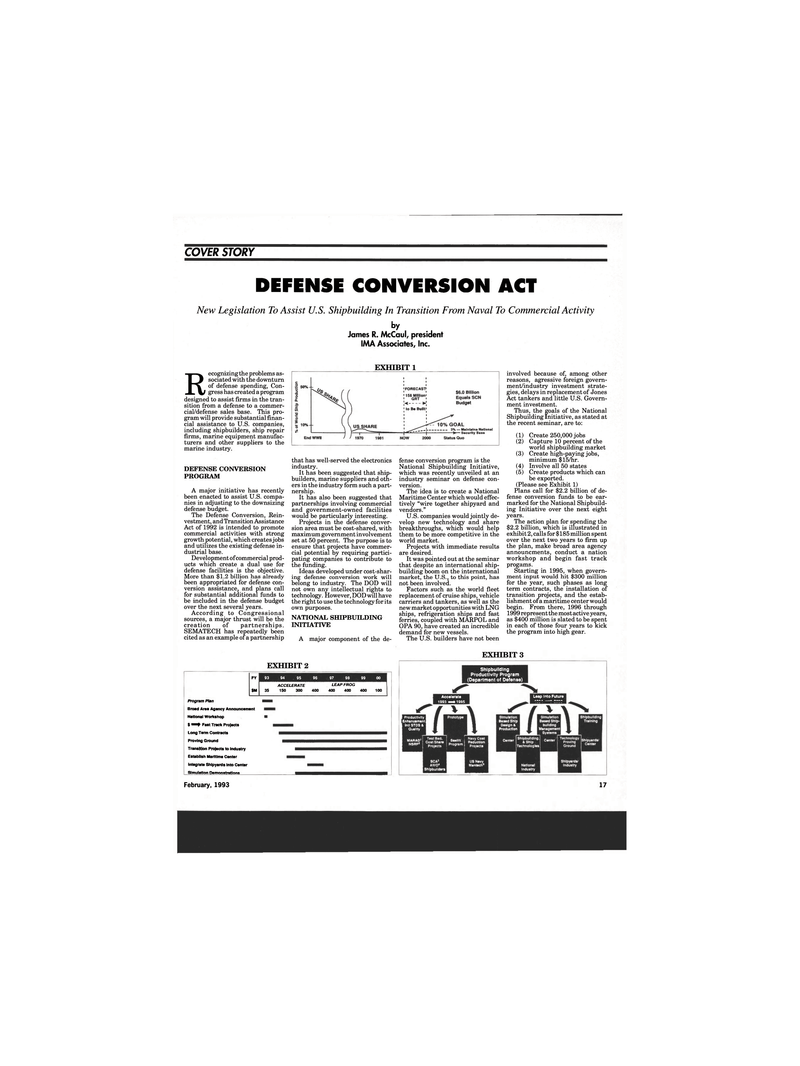
Page 15: of Maritime Reporter Magazine (February 1993)
Read this page in Pdf, Flash or Html5 edition of February 1993 Maritime Reporter Magazine
COVER STORY
DEFENSE CONVERSION ACT
New Legislation To Assist U.S. Shipbuilding In Transition From Naval To Commercial Activity by
James R. McCaul, president
IMA Associates, Inc.
EXHIBIT 1 R ecognizing the problems as- sociated with the downturn of defense spending, Con- gress has created a program designed to assist firms in the tran- sition from a defense to a commer- cial/defense sales base. This pro- gram will provide substantial finan- cial assistance to U.S. companies, including shipbuilders, ship repair firms, marine equipment manufac- turers and other suppliers to the marine industry.
DEFENSE CONVERSION
PROGRAM
A major initiative has recently been enacted to assist U.S. compa- nies in adjusting to the downsizing defense budget.
The Defense Conversion, Rein- vestment, and Transition Assistance
Act of 1992 is intended to promote commercial activities with strong growth potential, which creates jobs and utilizes the existing defense in- dustrial base.
Development of commercial prod- ucts which create a dual use for defense facilities is the objective.
More than $1.2 billion has already been appropriated for defense con- version assistance, and plans call for substantial additional funds to be included in the defense budget over the next several years.
According to Congressional sources, a major thrust will be the creation of partnerships.
SEMATECH has repeatedly been cited as an example of a partnership that has well-served the electronics industry.
It has been suggested that ship- builders, marine suppliers and oth- ers in the industry form such a part- nership.
It has also been suggested that partnerships involving commercial and government-owned facilities would be particularly interesting.
Projects in the defense conver- sion area must be cost-shared, with maximum government involvement set at 50 percent. The purpose is to ensure that projects have commer- cial potential by requiring partici- pating companies to contribute to the funding.
Ideas developed under cost-shar- ing defense conversion work will belong to industry. The DOD will not own any intellectual rights to technology. However, DOD will have the right to use the technology for its own purposes.
NATIONAL SHIPBUILDING
INITIATIVE
A major component of the de- fense conversion program is the
National Shipbuilding Initiative, which was recently unveiled at an industry seminar on defense con- version.
The idea is to create a National
Maritime Center which would effec- tively "wire together shipyard and vendors."
U.S. companies would jointly de- velop new technology and share breakthroughs, which would help them to be more competitive in the world market.
Projects with immediate results are desired.
It was pointed out at the seminar that despite an international ship- building boom on the international market, the U.S., to this point, has not been involved.
Factors such as the world fleet replacement of cruise ships, vehicle carriers and tankers, as well as the new market opportunities with LNG ships, refrigeration ships and fast ferries, coupled with MARPOL and
OPA 90, have created an incredible demand for new vessels.
The U.S. builders have not been involved because of, among other reasons, agressive foreign govern- ment/industry investment strate- gies, delays in replacement of Jones
Act tankers and little U.S. Govern- ment investment.
Thus, the goals of the National
Shipbuilding Initiative, as stated at the recent seminar, are to: (1) Create 250,000 jobs (2) Capture 10 percent of the world shipbuilding market (3) Create high-paying jobs, minimum $15/hr. (4) Involve all 50 states (5) Create products which can be exported. (Please see Exhibit 1)
Plans call for $2.2 billion of de- fense conversion funds to be ear- marked for the National Shipbuild- ing Initiative over the next eight years.
The action plan for spending the $2.2 billion, which is illustrated in exhibit 2, calls for $185 million spent over the next two years to firm up the plan, make broad area agency announcments, conduct a nation workshop and begin fast track progams.
Starting in 1995, when govern- ment input would hit $300 million for the year, such phases as long term contracts, the installation of transition projects, and the estab- lishment of a maritime center would begin. From there, 1996 through 1999 represent the most active years, as $400 million is slated to be spent in each of those four years to kick the program into high gear.
EXHIBIT 3
EXHIBIT 2
FY 93 94 95 96 97 98 99 00
ACCELERATE LEAPFROG $M 35 150 300 400 400 400 400 100
Program Plan
Broad Area Agency Announcement
National Workshop $ Fast Track Projects
Long Term Contracts
Proving Ground
Transition Protects to Industry
Establish Maritime Center
Integrate Shipyards Into Center
Simulation Demonstrations
Productivity
Enhancement
Intl STDS &
Quality
Shipbuilding
Productivity Program (Department of Defense)
Accelerate 1993 —41995
Leap Into Future ifiari ^Mfc onnn
February, 1993 17

 14
14

 16
16
